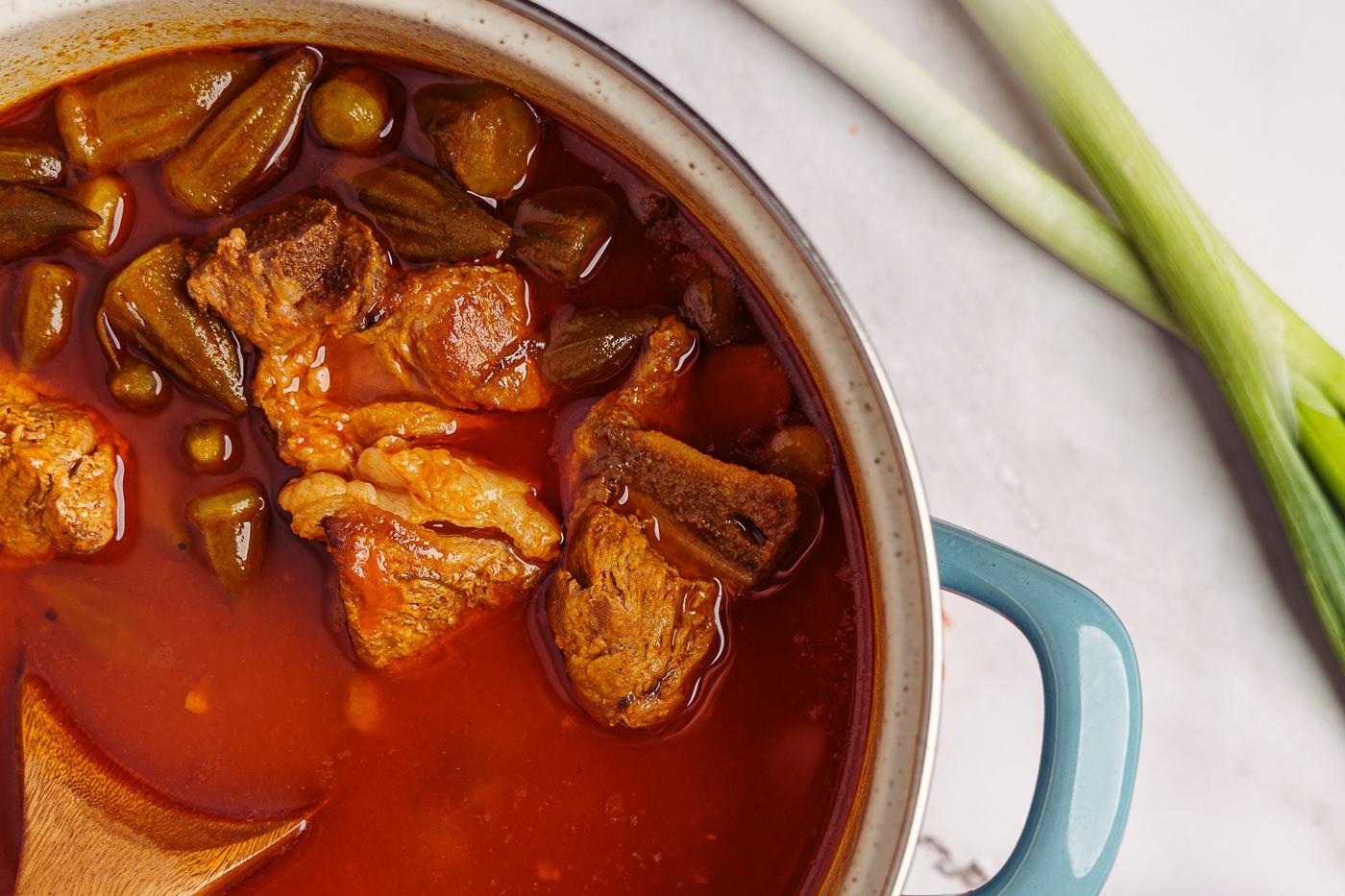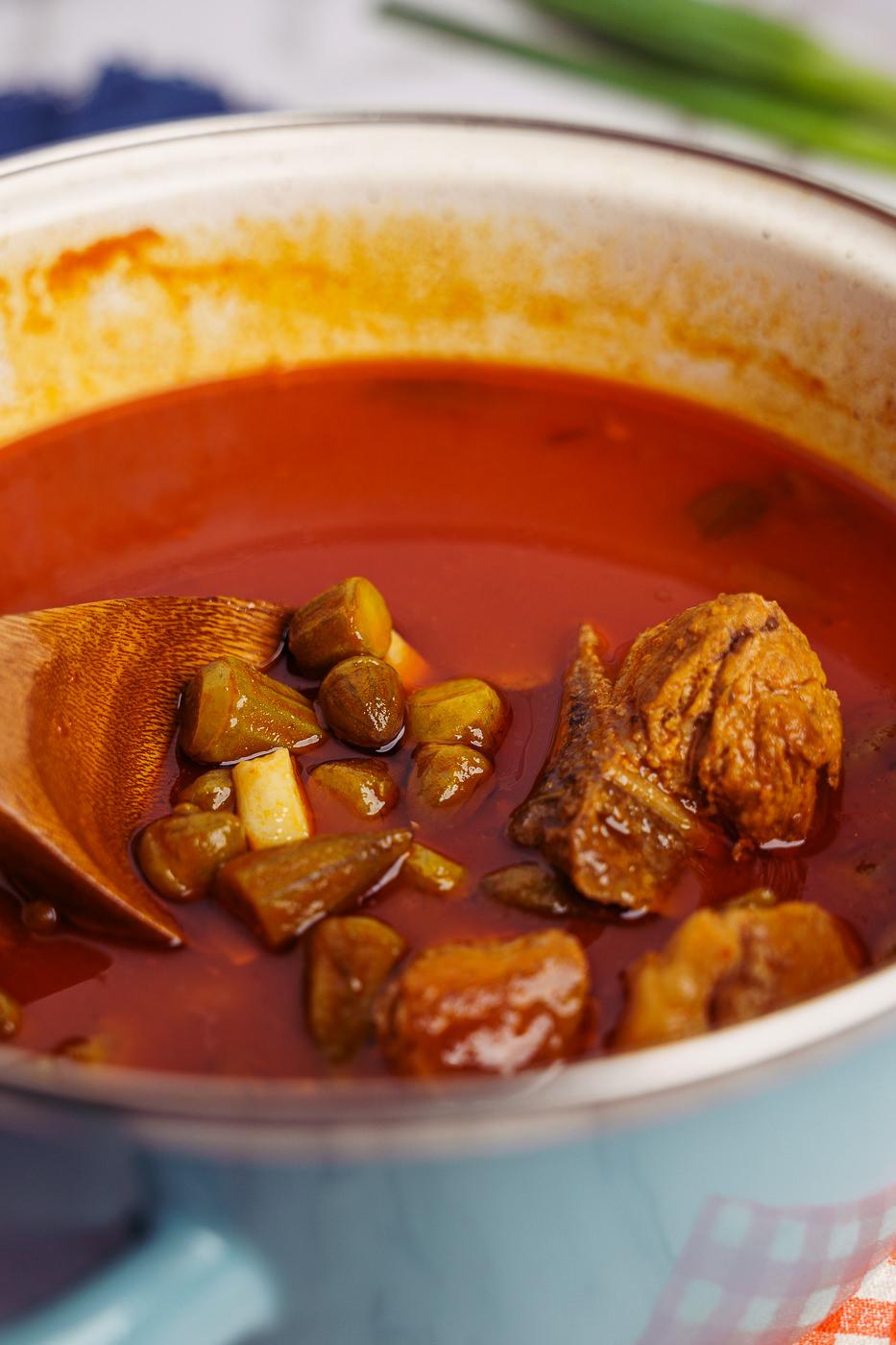Bamia stew, a flavorful dish featuring tender okra, is a beloved meal across the Middle East. Okra, meat (lamb, beef or veal), tomato paste, garlic, and rich broth come together to create Iraqi Bamia, a hearty stew. Okra shines in this dish, and the earthy flavors make it a Middle Eastern comfort food staple.

Origins of Bamia Stew
“Bamia” or “Bamya” comes from the Arabic word for okra, and the stew has ancient roots. Early Persian references suggest it originated in Egypt, where okra was already a key ingredient. It grown in ancient Egypt, and spread to the Middle East, and over time, Bamia became a staple due to its compatibility with lamb and tomato-based broths.

During okra season, families would prepare it in bulk—sorting, trimming, drying, and freezing to use year-round. I remember as a kid, my father buying it in bulk, and my family sitting together, sorting by size and trimming the tops. We’d dry some for later and freeze the rest, making every Bamia meal feel special because of the effort we put into preserving it.

What is Bamia stew?
The Iraqi version of Bamia stew usually includes lamb/ beef/ veal, tomatoes, garlic, and sometimes onion, though some households may skip onions to keep the flavors simple. Traditionally, okra is cooked until tender, absorbing the richness of the tomato broth and meat. While fresh okra is preferred, frozen okra can be a time-saving substitute without sacrificing flavor.

What is Okra?
Okra, also known as “lady’s fingers,” is a green, pod-shaped vegetable with a mild, earthy flavor and a slightly slimy texture when cooked. Its small, edible seeds are encased within the pod, which is usually around 2-5 inches in length, depending on the variety. Okra is commonly used in soups, stews, and stir-fries across many cuisines worldwide.

Ingredients needed to make Bamia
- Frozen Okra: Frozen okra saves time since it’s pre-trimmed and ready to use without needing cleaning, cutting, or thawing.
- Bone-in Veal : Veal is usually leaner than lamb. This result in a lighter stew, which I prefer to avoid a heavier, fattier dish.
- Garlic: In Iraqi Bamia, garlic is a must-have ingredient. Some prefer a milder flavor (which I like), while others enjoy a stronger garlic taste, adding an entire head of garlic to the stew (with peel on). Garlic adds warmth and depth to Bamia stew.
- Tomato Paste: using tomato paste make the cooking process faster by skipping the extra step of juicing fresh tomatoes. And the stew tastes just as flavorful and satisfying.
- Salt and Black Pepper: These are the only seasoning needed.
- Refined Coconut Oil: which what I usually use in my house, but any cooking oil works.
- Boiling water: For cooking meat, and for cooking stew.
- Meat Broth: we will get it after the veal is cooked. It add rich, deep flavors to the Bamia, especially bone-in veal cuts.

How to make Iraqi Bamia step by step
- In a large pot heat oil over medium heat. Add the bone-in veal cuts and sear for 4-5 minutes on each side until browned. This step helps to lock in the meat’s juices and adds flavor to the stew.
- Pour boiling water over the veal, making sure the meat is fully submerged. Do not add salt at this stage.
- Cover the pot, bring to a boil for 35-45 minutes until the meat is tender and the broth has formed.
- Once the meat is done, remove it from the pot and set it aside. Keep the broth.

- In the same pot, heat another tablespoon of oil. Add the frozen okra directly to the pot along with the sliced garlic. Do not thaw.
- Sear them gently, stirring occasionally, for 3-5 minutes until the garlic is fragrant and the okra begins to soften slightly.

- Return the seared veal and its broth to the pot.
- Add the tomato paste. Season with salt and black pepper to taste.
- Pour additional boiling water as needed to ensure the stew has enough liquid.

- Stir gently until the tomato paste dissolves completely into the liquid. Cover and bring to a boil over medium heat.
- Let the stew cook for 20-30 minutes, checking the okra for tenderness. Stir occasionally, being gentle to avoid breaking the okra pods.
- If the okra is still firm, add more boiling water and continue simmering for another 10-15 minutes until the okra is fully tender.

- If the stew becomes too thick, simply add a bit more boiling water to reach your preferred consistency.
- Once the okra is tender and the stew has thickened, remove from heat and serve hot, alongside rice or torn flatbread (Tashreeb Bamia style).

Iraqi Bamia FAQ’s
Here are some common questions about Bamia stew, to help clarify common queries about cooking and serving Bamia stew.
- What’s the best meat to use for Bamia stew?
- Lamb or veal with bone-in cuts are commonly used, adding rich flavor to the broth. Beef is also a good substitute.
- Can I use fresh okra instead of frozen?
- Yes, fresh okra can be used, but it requires more prep work, like trimming and washing, whereas frozen okra is already prepped and ready to use.
- What’s the difference between fresh and frozen okra in this recipe?
- Frozen okra is convenient and often just as flavorful as fresh okra, while fresh okra requires more prep time.
- Does Bamia stew need garlic?
- Yes, garlic is essential for authentic Iraqi Bamia. Some prefer it mild with a few cloves, while others add a whole head for a stronger flavor.
- Why does this recipe only use tomato paste instead of tomato juice or sauce?
- Using only tomato paste gives the stew a rich, concentrated flavor while keeping the recipe simple. The stew still tastes delicious and authentic, even without tomato juice or canned sauce.
- Why isn’t there any spice in Iraqi Bamia?
- The flavors come from the garlic, tomato, and meat broth, making it flavorful without needing additional spices.
- What should I serve with Bamia stew?
- Bamia is traditionally served with white rice or vermicelli rice, and in Iraq, it’s sometimes served as Tashreeb over torn traditional flatbread soaked in the broth.
- Can I freeze leftover Bamia stew?
- Yes, Bamia stew freezes well, making it a great meal to prepare in advance and reheat later.
- How can I make Bamia stew vegetarian?
- You can make a vegetarian version by omitting the meat and using vegetable broth instead. The okra and tomato paste still create a flavorful dish.

Here’s some recipes you might want to check out
- Beef Kofta Kebab ( Middle eastern kofta )
- Tabouleh (Middle Eastern Parsley Salad)
- Gers Ogaili ( Middle Eastern Saffron and Cardamom Cake )
- Lahm Bi Ajeen (A Middle Eastern Pizza)

Bamia Stew ( Authentic Iraqi Okra Stew )
Ingredients
- 500 g bone-in Veal see notes for subs
- 400 g frozen okra not thawed
- 5 cloves of garlic sliced
- 3 tbsp tomato paste see notes for subs
- 6 cups water boiling
- salt to taste
- ground black pepper to taste
- 3 tbsp refined coconut oil or your preferred type
Instructions
- In a large pot heat oil over medium heat. Add the bone-in veal cuts and sear for 4-5 minutes on each side until browned.
- Pour boiling water over the veal, making sure the meat is fully submerged. Do not add salt at this stage.
- Cover the pot, bring to a boil for 35-45 minutes until the meat is tender and the broth has formed.
- Once the meat is done, remove it from the pot and set it aside. Keep the broth.
- In the same pot, heat another tablespoon of oil. Add the frozen okra directly to the pot along with the sliced garlic. Do not thaw.
- Sear them gently, stirring occasionally, for 3-5 minutes until the garlic is fragrant and the okra begins to soften slightly.
- Return the seared veal and its broth to the pot.
- Add the tomato paste. Season with salt and black pepper to taste.
- Pour additional boiling water as needed to ensure the stew has enough liquid.
- Stir gently until the tomato paste dissolves completely into the liquid. Cover and bring to a boil over medium heat.
- Let the stew cook for 20-30 minutes, checking the okra for tenderness. Stir occasionally, being gentle to avoid breaking the okra pods.
- If the okra is still firm, add more boiling water and continue simmering for another 10-15 minutes until the okra is fully tender.
- Remove from heat and serve hot, alongside rice or torn flatbread (Tashreeb Bamia style)
Notes
- If you can’t find veal, lamb or beef shank with bones are great substitutes. Adjust the cooking time based on the type of meat.
- Make sure not to overcook stew to avoid mushiness.
- You can use canned tomato sauce or fresh tomatoes. If you do use fresh tomatoes, blend and strain them for a smooth texture, but note that you’ll need to cook the stew longer to thicken it.
- you may need to add more tomato paste depend on the brand and how thick it is.
- Bamia is traditionally served with white rice or vermicelli rice, and in Iraq, it’s sometimes served as Tashreeb over torn traditional flatbread soaked in the broth.
- Bamia stew freezes well, making it a great meal to prepare in advance and reheat later.






